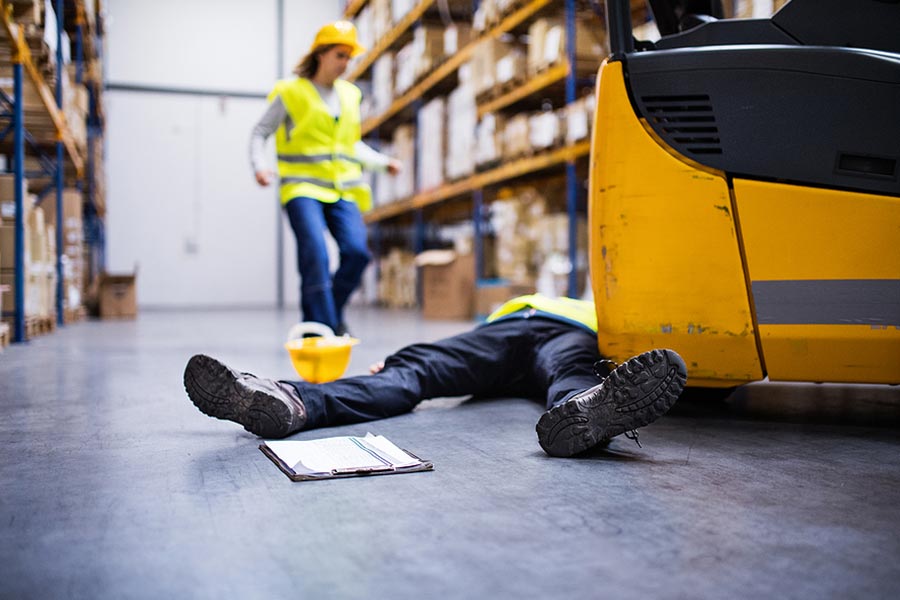Where a forklift is an extremely useful and versatile piece of equipment for warehouses across the country, when operated incorrectly or without due care and attention, they can pose a significant risk to forklift drivers, workers on the ground and the inventory you’re transporting. So what are the most common forklift accidents and what can you do to try and prevent them?
Toppling forklifts
Uneven terrain coupled with loads that aren’t adequately positioned on the forks can cause a forklift to topple over, especially if the load it’s carrying is heavy also. Of course, this can pose a threat to your workers as well as damage your forklift and your inventory.
The best way to minimise this threat is to identify uneven ground where forklifts are likely to be navigating and have them smoothed over. Fill in potholes, watch out for drains and add safety and hazard warnings just before steep slopes as these often cannot be rectified.
Loads falling from the vehicle
If a loose load falls from the forks, it could land on a passerby. You need to minimise this risk by ensuring all loads are adequately and securely lifted, raised and unloaded. This is essential as it could cause serious or even fatal injuries to workers on the floor, especially if it’s large and/or heavy. Handling loads safely should make up part of the forklift training that all of your operators should receive before getting behind the wheel.
Racking failures
Where this isn’t directly related to forklift accidents, a forklift could cause racking to fail, especially if it’s caught by forks or if heavy loads are dropped onto shelving incorrectly. Forklifts could also end up reversing or accelerating directly into the warehouse racking due to human error.
A mistake such as this, coupled with weak or old warehouse racking could spell disaster, causing injury to your workers, damaging stock and even damaging warehouse equipment. Not to mention you’d then have to spend money replacing your racking. Adequate forklift training should prevent these mishaps from happening.
Collisions with objects
This is not an uncommon problem and is almost an extension to the last point about backing forklifts into warehouse racking. However, forklifts can also run into other structures and objects, such as lockers, desks and other pieces of material handling equipment.
As well as damaging the forklift, people could be hurt and the objects they hit could topple and fall onto passersby. Reiterate to your forklift operators the importance of steady driving, patience and careful manoeuvring, especially in tight spaces and narrow aisles. One of the ways in which you can prevent this is by implementing the right equipment, such as multi-directional forklifts and VNA forklifts from Refurbished Forklifts.
Collisions with pedestrians
Collisions with pedestrians on the ground can cause considerable harm and even fatalities depending on the circumstances. Whether you run over someone’s foot by accident, or accidently crush a warehouse worker by pinning them against the back end of a forklift and another object, it should still be considered a serious incident that should be dealt with as per regulations. Prevent this by training your forklift operators properly, ensuring they fully-understand the importance of safe, steady and patient forklift operation before getting behind the wheel.
Falling out of the forklift
It might sound unlikely, but a forklift operator could come to harm getting out of the vehicle. Exiting the forklift should form part of the forklift training as they can be rather high off the ground and the drivers’ footing needs to be correct in order to get out of the vehicle as safely as possible.
As well as failing to use handlebars, steps and other aids, forklift drivers could also happen upon slippery, wet or uneven surfaces when getting out of their forklift. With this in mind, operators should assess the ground they’re about to step out onto before exiting the vehicle and use all of the aids available to them in order to get out of the forklift as safely as possible.
Speeding whilst operating the forklift
It’s important when forklifts are in operation that operators travel at a reasonable, safe speed at all times and with the forks as close to the ground as possible to avoid an accident. Extra care should be taken if the forklift is carrying a load of any size. The forklift should also be operated slowly around corners and bends and if travelling across varying gradients, rough, loose or uneven terrain.







